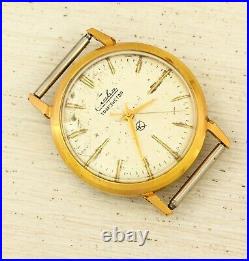
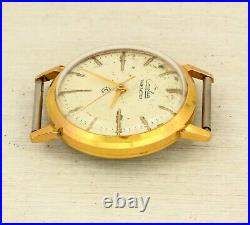
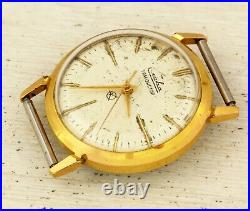
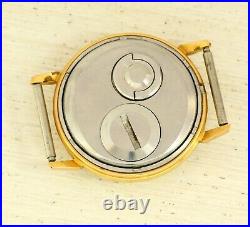
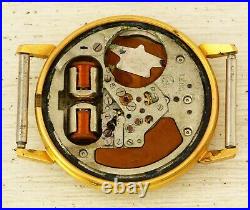
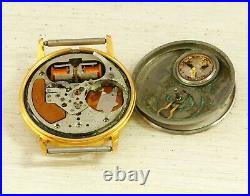
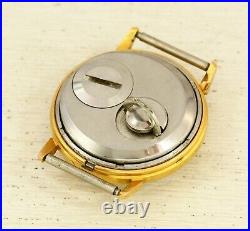
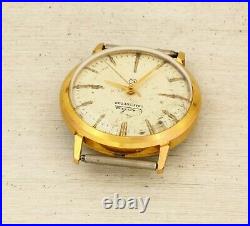

SLAVA TRANSISTOR (tranzistor) very rare tuning fork gold plated USSR men’s wristwatch from 1960’s. Made in USSR (Soviet, Russian,). It would be great find for any collector. Please see the photos for the assessment of watches. Really watches look much better than in the photo. In horology the term electric watch is used for the first generation electrically-powered wristwatches which were first publicly displayed by both Elgin National Watch Company and LIP on the 19th of March 1952 with working laboratory examples in Chicago and Paris. Hamilton would be the first to produce and retail an electric watch beginning in 1957, before the commercial introduction of the quartz wristwatch in 1969 by Seiko with the Astron. Their timekeeping element was either a traditional balance wheel or a tuning fork, driven electromagnetically by a solenoid powered by a battery. The hands were driven mechanically through a wheel train. They were superseded by quartz watches, which had greater accuracy and durability due to their lower parts count. Recent automatic quartz watches, which combine mechanical technology with quartz timekeeping, are not included in this classification. A weak point in early balance wheel electric watches was the switch contacts on the balance wheel, which turned the solenoid on briefly to provide the impulse to keep the wheel oscillating. These wore out and did not operate reliably. Later designs used electromagnetic sensing, with a transistor in the circuit to turn the solenoid on. Types of electric watches. Moving coil system, contact controlled: refers to watches with a balance wheel with integrated coil, fixed magnets and mechanical contacts. Examples of this technology are Hamilton 500 (first retail electric watch in 1957), Epperlein 100, Champion (Ruhla / UMF), Slava 114ChN and Timex M40. Fixed coil system, contact controlled: watches with a piece of refined iron attached to the balance wheel, a fixed coil and mechanical contacts. In order to extend the life of the watch, some of these movements included a diode to minimize sparking on the contacts. Examples of this technology are Lip electronic R 27, LIP R 148, Elgin electronic 722, 725, 910 which were the smallest electronic movements ever made and Landeron ESA – Ebauches S. Transistorized watches with balance: had a balance wheel, a transistor acting as a switch and no mechanical contacts. Usually the coil was located in the base plate and the magnets are on the balance wheel. Watches using this technology include Timex M87/Laco 882, Citizen X-8 series and Seiko Electronic 31A. Another common example is ESA Dynotron cal. Tuning fork watches: Instead of a balance wheel, these watches used a tuning fork driven by a solenoid powered by a one-transistor oscillator circuit and no mechanical contacts. The tuning fork had an attached pawl and’index wheel’, which turned the gear train. The common frequencies used in watches were 300 Hz ESA MOSABA cal. 9162, 9164 and 9210, 360 Hz Bulova Accutron cal. 214 and 218, Slava Transistor, Tianjin’Yinchabiao’, Prim Elton, 480 Hz Bulova Accutron cal. 2300 and 720 Hz Omega Megasonic cal. Omega F300Hz and Speedsonics series are common examples of ESA MOSABA based watches. COUNTRY OF ORIGIN: USSR. OVERALL CONDITION (10-point scale): 7-8. Gold plated AU 20 (Aurum 20 micron). It has 20 Micron gold plating. Gilding 20 microns – the biggest thickness of gilding in the USSR! Inscriptions on the dial. Slava Transistor and Camerton logo. Electronically controlled tuning fork. 1.32 inch (33.5 mm). 1.57 inch (40.0 mm). 0.51 inch (13.0 mm). 1.16 inch (29.5 mm). 1.02 oz (29.0 g). Meaning “Glory” watches were classic “civil” Russian watches commonly referred to as Slava Lava! The Slava factory (known originally as the Second Moscow Watch Factory) was the second non-military watch maker established in the Soviet Union, in 1924. The watches of this brand have always been meant for civilian consumption, without military or aerospace pretensions. Slava’s own mechanical movements feature two mainspring barrels coupled together with an idler gear. There are many versions of the movement including manual wind 2414 and 2428(double date)and self-winding 2416 and 2427 (double date). 1964 year – on the Leipzig international fair Slava tuning-fork wrist watch got gold medal. 1974 year – Slava watches got gold medal at Brno fair. 1975 year – gold medal at Leipzig international fair. While Slava watches utilize its own Russian-made movements today, and for some models, bought-in movements from Miyota are used. All Antique watches are mechanical. Many repairs will not be cheap, as most likely they will require replacement of non-standard parts (unlike most late model watches). Antique watches should not be beaten or dropped – because repairs may be expensive. Antique watches are generally NOT waterproof. This is because waterproofing was not in general production until the middle of the 20th century for most watches. Therefore you should protect your antique watch from exposure to moisture. If your watch becomes wet it should be dried off quickly. Carefully open all covers and use a hair drier to blow dry the movement, dial, covers, crown. This will reduce the amount of rust. If your watch becomes wet with any kind of salt water you should immediately immerse or spray your watch with fresh (no-salt) water to remove all the salt from the works before drying the watch completely. Any salt left in the watch will combine with moisture in the air to rust metal components of the movement, case etc. Winding any mechanical watch tight may break the mainspring. If you can avoid it do not wind the watch hard. When adjusting the hands of your watch, move them in a clockwise direction only. Counter-clockwise adjustments may damage the movement. It is desirable to adjust the hands of your watch at the same time every day. An automatic or self-winding watch should be worn for at least 8 hours a day. It is a mechanical watch in which the mainspring is wound automatically as a result of natural motion of the wearer’s arm, to provide energy to run the watch, making manual winding unnecessary. If you must adjust counter-clockwise make it for small adjustments only i. For minutes, NOT hours. Be careful and gentle when adjusting the movement speed (faster or slower). Don’t make sharp movements, and don’t touch other components in the movement especially the pendulum mechanism. Every 2-3 years it is necessary to service and oil vintage watches. If the course of your watches is worsening and the accuracy of the reduction in the duration of the clock (autonomy) from one fully wound spring – it need a service. IF the watch is dirty – allow the watch to run down, don’t wind it again until you have it serviced by a qualified watch repair expert. Dust will absorb and remove important lubricants and cause the movement pieces to wear down. To clean the case, dial and crystal you should use a cloth that does NOT leave fibers as these may get caught up in the movement. Check with your Watch repair expert to get an appropriate cloth. Keep your antiques watch away from magnets. Strong magnetic fields may affect the accuracy of your watch since some vintage watches were made with iron based components in the movement. Most Cases and Covers are fine components and will not handle abuse well. The watch should not be shaken, beaten, or stressed. Antique watches generally experience an error of up to 5-7 minutes a day. Any accuracy of +- 5 minutes is very good. Mechanical watch is not recommended to use for engage in extreme sports, and expose them to excessive vibration loads. Recoil force, which take on the clock, affect their reliability and precision. No matter how perfect was not anti-shock mechanism, there is always the chance of excessive load that details of the mechanism can not survive. It is not recommended to adjust, the date between 20.00 and 06.00, because at this time involved a mechanism for automatic adjustment date. Translation pointers calendars manually in this position arrows may damage the mechanism. Date changes should be made, relegating pre-clockwise to lower sector of the dial for example, to position 6 (18.00) hours. In most cases, these watches contain the “start/stop” button and “reset” button. It is strongly recommended not to press the “reset” if the chronograph is running. Before you use the “Reset” button need to stop the chronograph by button “start/stop”. Using the “reset” when running chronograph can damage the mechanism of most models of watches. USA, Japan & other. In spite of delays all our previous lots have been successfully delivered! The item will be packed very carefully! United States of America, Canada, Australia, Albania, Algeria, Andorra, Antigua and Barbuda, Argentina, Armenia, Aruba, Austria, Azerbaijan, Bahamas, Bahrain, Bangladesh, Barbados, Belgium, Bermuda, Bolivia (Plurinational State of), Bosnia and Herzegovina, Brazil, Bulgaria, Cambodia, Chile, China, Colombia, Costa Rica, Croatia, Curaçao, Cyprus, Czech Republic, Denmark, Dominican Republic, Ecuador, Egypt, El Salvador, Estonia, Finland, France, Georgia, Germany, Gibraltar, Greece, Guadeloupe, Hong Kong, Hungary, Iceland, India, Indonesia, Ireland, Israel, Italy, Jamaica, Japan, Kazakhstan, Kuwait, Latvia, Liechtenstein, Lithuania, Luxembourg, Macedonia (the former Yugoslav Republic of), Malaysia, Malta, Mexico, Moldova (Republic of), Monaco, Mongolia, Montenegro, Morocco, Nepal, Netherlands, New Zealand, Norway, Oman, Panama, Paraguay, Peru, Philippines, Poland, Portugal, Qatar, Romania, Saudi Arabia, Senegal, Serbia, Singapore, Slovakia, Slovenia, South Africa, Korea (Republic of), Spain, Sri Lanka, Sweden, Switzerland, United Arab Emirates, United Kingdom of Great Britain and Northern Ireland, Uruguay, Viet Nam. There are no exceptions! It is impossible to address issues if we do not know about them! Thank you for your interest in our products! Please let me know if you have any questions. The item “SLAVA TRANSISTOR (tranzistor) very rare tuning fork gold plated USSR wristwatch” is in sale since Monday, December 14, 2020. This item is in the category “Jewelry & Watches\Watches, Parts & Accessories\Watches\Wristwatches”. The seller is “dmytro_yaroshenko” and is located in cherkassy, herkaska oblast. This item can be shipped worldwide.
- Features: 12-Hour Dial
- Case Size: 33.5 mm
- Age Group: Adult
- Lug Width: 18 mm
- Department: Men
- Handmade: No
- With Service Records: No
- Display: Analog
- Modified Item: No
- Case Color: Gold
- Vintage: Yes
- Country of origin: USSR
- Indices: 12-Hour Dial
- Case Material: Gold Plated
- Water Resistance: Not Water Resistant
- Handedness: Left
- Year Manufactured: 1960-1969
- Customized: No
- Case Finish: Gloss
- Model: Slava Transistor
- Band Width: 18 mm
- Seller Warranty: No
- With Manual/Booklet: No
- Band Material: without
- With Papers: No
- With Original Box/Packaging: No
- Reference Number: Does Not Apply
- Dial Color: White
- Band Color: not
- Brand: Slava
- Style: collectible
- Gender: Men’s
- Band Type: no band
- Caseback: Screwback
- Watch Shape: Round
- Theme: dress
- Case Thickness: 12 mm
- Movement: tuning fork
- Type: Wristwatch

